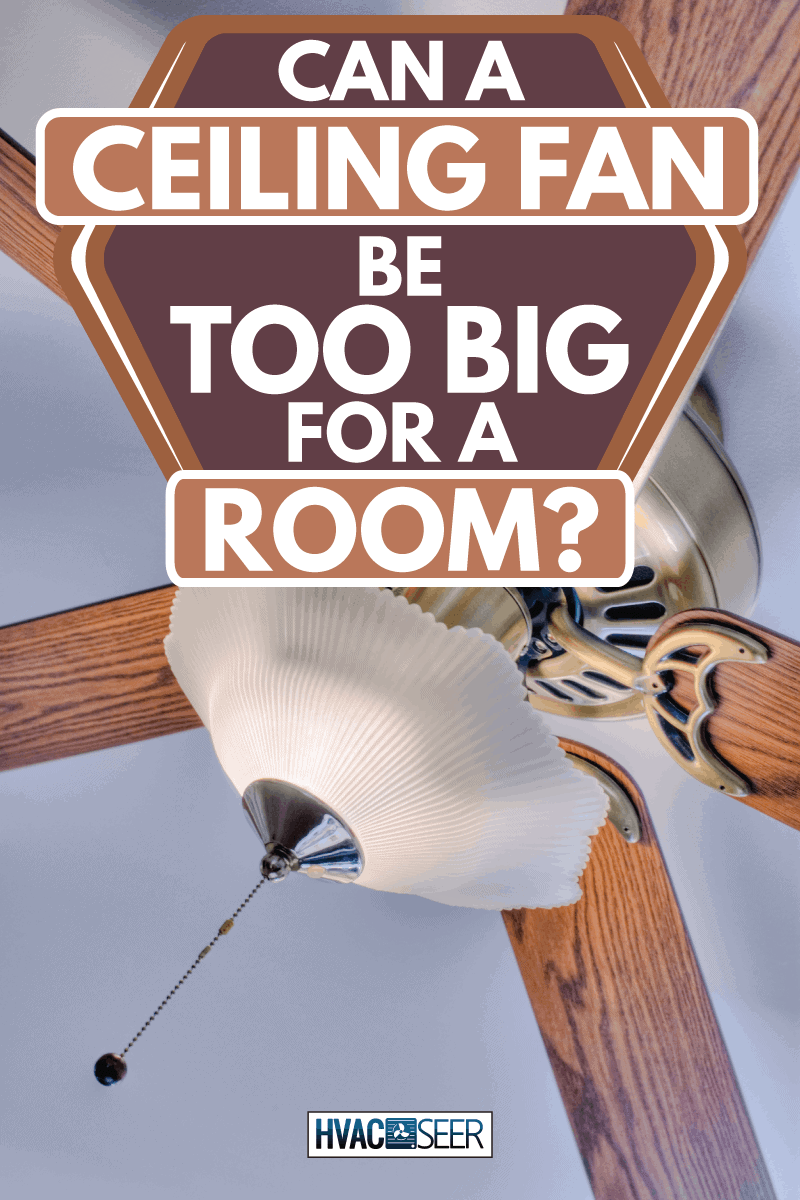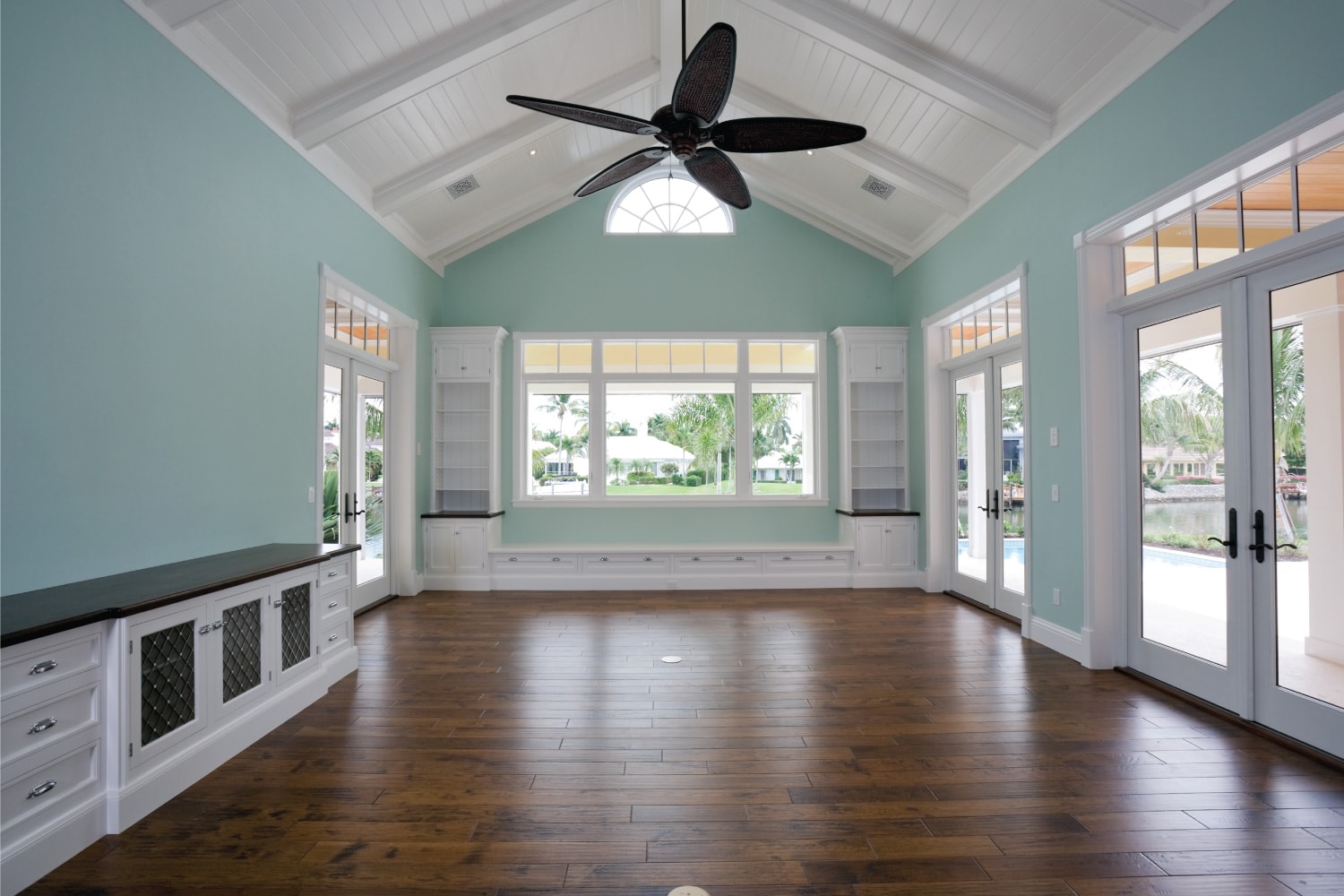Ceiling fans not only look nice but help to keep the room feeling cool. There is nothing better on a warm summer night than a gentle breeze. You might want to get the biggest fan possible, but can a ceiling fan be too big for a room? We've investigated how to properly size a ceiling for any room to get the answer for you.
Size does matter when it comes to ceiling fans. In order to choose the right ceiling fan, it is important to know the dimensions of the room and consider these other aspects to prevent getting a fan that is too big:
- Square footage of the room
- Length and width of the room
- Ceiling height
- Ceiling type - flat vs. sloped
Ceiling fans come in many sizes; they also usually have a mounting rod to adjust drop height (this feature is optional). In this article, you will find the basic size requirements for ceiling fans, how to measure ceiling fans, and what to consider so you can find just the right fan for your space.

Sizing A Ceiling Fan
Before getting started to even look at ceiling fans, it helps to know how they are measured. So, let's take a closer look at ceiling fan dimensions before moving on to the room considerations that we've previously mentioned.
How to Measure A Ceiling Fan
Ceiling fans are sized by diameter. Just measure the distance from the edge of the blade to the center of the fixture -double that figure. For example, a 40" fan will have a blade length of 20" (from blade tip to fixture center). Now, let's discuss what to consider to choose the size of your fan.
Square Footage of The Room
Firstly, consider how big your room is. You can follow this rule of thumb to choose fan size for typical room sizes, taking into consideration that ceiling fans should always be mounted in the center of the room:
- 8' x 12' room - 40" fan
- 12' x 14' room - 42" to 54" fan
- 18' x 20' room - 52"to 60" fan
Length and Width of The Room

You might consider installing a ceiling fan in a long, narrow space, like a three-season porch or a breezeway. The simple rule of thumb discussed above would not work to get the right proportion fan for this area. The most important thing to remember for long, narrow spaces is that to optimize the air circulation. There should be a minimum of 18" clearance between the edge of the fan's blades and the wall. If the room is very long and narrow, you may need to install multiple fans with at least 39" clearance between each.
To install two 40" fans in the same room, you will have to measure at least 18" from the wall to the first fan's installation point, plus 20" to account for blade length. Ideally, the fans should be 39" apart. The total length of the room should be no less than 12'11".
Ceiling Height
For proper air circulation, the blades need to be 8' to 9' above the ground. Any less than 7' clearance and the fan would not be effective. Not only that, it can be hazardous to tall people if hung too low. Most ceiling fans come with an optional rod to adjust the fan's height by dropping it from the ceiling. For example, on a vaulted ceiling, you can mount the fan from the rod rather than flush with the ceiling. On an 8' ceiling, you might flush mount the fan instead.
Ceiling Type - Flat Vs. Sloped
If the fan is installed on a slanted ceiling, it will affect the maximum fan size. You should maintain a clearance of 18" from the blades' tip to the wall. A 7' minimum height from the ground still applies. When buying the fan, you would need to verify that it can be installed on a slanted ceiling and that the extension rod comes in the right length for your needs. The ceiling's pitch should also be considered for determining how to mount the fan.
What Type of Ceiling Fan Moves The Most Air?

The four main fan qualities for air circulation are:
- Motor
- Diameter
- Number of blades
- Blade pitch
The stronger the motor and longer the blades (three blades are ideal) make for the most efficient fans. However, there are many caveats. Take, for instance, "How Many Blades Are Best On A Ceiling Fan?"
One thing to remember, though, is appearance. You can get a fan to follow these guidelines, and it can still be the wrong size for the room. A large fan might dominate the room, making the room look smaller without adding enough function. Aesthetics is as important as function when choosing a ceiling fan, so consider the room's existing style before buying the fan.
What Should I Look For in a Ceiling Fan?
- Size
- Efficiency
- Noise level
- How to control the fan (either from a wall switch, chords, or remotely)
- With or without a light fixture
We've thoroughly discussed fan size and selecting the best fit according to your room's size and shape. The number of blades and the motor's capability will influence the fan's efficiency and noise level. You'll have some function and style choices as well, such as how to operate the fan and whether it doubles as a light fixture.
Fan Control Methods
Older fans used to come with a chain. You controlled the light switch (if applicable) with the shorter chain and the fan's speed with the longer chain. It was simple unless the chain was too high to reach. Many modern fans still offer chain or chord control and provide remote operation features -even from your smartphone! While remotes can get lost and require batteries, they are also much more convenient. Most remotes come with wall-mount capabilities, so they can be used as a switch as well.
Light Fixture Optional
While that is a personal preference, most ceiling fans today are sold with a built-in light fixture. The light and fan blades can be used independently of one another. For some rooms, a ceiling light is advantageous. Combining the fan with a light fixture can be a pleasing piece of decor in your room.
Can a 52" Fan Fit in The Bedroom?
https://www.istockphoto.com/photo/country-house-bedroom-gm1218697300-356198893
Yes, a 52" can fit in a bedroom -as long as you consider the guidelines for room size. The bedroom should be at least 12 'x 14' or larger, with a floor clearance of at least 7' for this size fan. The bed's height is the only additional consideration, especially if it is lofted or a bunk bed.
Check out this 52" fan on Amazon.
Does A Ceiling Fan Require Maintenance?
As long as they are mounted correctly, ceiling fans are quite safe and require very little to no maintenance. At the least, it should be dusted regularly. Dusting can be easily achieved using a duster on a pole. Older fans from the 70s might also need to be oiled every few years. For more on fan maintenance, check out "Do Ceiling Fans Need to be Oiled?"
Check out telescoping Swiffer on Amazon.
To Conclude
When choosing a ceiling fan, it is important first to know what you want to achieve. Consider the dimensions of the room both for function and aesthetics. Also, consider what is noise tolerance, as the hum of the fan can be soothing to some but irritating to others. Finally, think about adding a ceiling light fixture as part of your fan.


